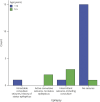Novel ALDH5A1 variants and genotype: Phenotype correlation in SSADH deficiency
- PMID: 32887777
- PMCID: PMC7713737
- DOI: 10.1212/WNL.0000000000010730
Novel ALDH5A1 variants and genotype: Phenotype correlation in SSADH deficiency
Abstract
Objective: To determine genotype-phenotype correlation in succinic semialdehyde dehydrogenase (SSADH) deficiency.
Methods: ALDH5A1 variants were studied with phenotype correlation in the SSADH natural history study. Assignment of gene variant pathogenicity was based on in silico testing and in vitro enzyme activity after site-directed mutagenesis and expression in HEK293 cells. Phenotypic scoring used a Clinical Severity Score (CSS) designed for the natural history study.
Results: Twenty-four patients were enrolled (10 male, 14 female, median age 8.2 years). There were 24 ALDH5A1 variants, including 7 novel pathogenic variants: 2 missense, 3 splice site, and 2 frameshift. Four previously reported variants were identified in >5% of unrelated families. There was a correlation with age and presence (p = 0.003) and severity (p = 0.002) of epilepsy and with obsessive-compulsive disorder (OCD) (p = 0.016). The median IQ score was 53 (Q25-Q75, 49-61). There was no overall correlation between the gene variants and the CSS, although a novel missense variant was associated with the mildest phenotype by CSS in the only patient with a normal IQ, whereas a previously reported variant was consistently associated with the most severe phenotype.
Conclusions: Seven novel pathogenic and one previously unpublished benign ALDH5A1 variants were detected. There is an age-dependent association with worsening of epilepsy and presence of OCD in SSADH deficiency. Overall, there does not appear to be a correlation between genotype and phenotypic severity in this cohort of 24 patients. We did find a suspected correlation between a novel pathogenic missense variant and high functionality, and a previously reported pathogenic missense variant and maximal severity.
© 2020 American Academy of Neurology.
Figures




Similar articles
-
Succinic Semialdehyde Dehydrogenase Deficiency: In Vitro and In Silico Characterization of a Novel Pathogenic Missense Variant and Analysis of the Mutational Spectrum of ALDH5A1.Int J Mol Sci. 2020 Nov 13;21(22):8578. doi: 10.3390/ijms21228578. Int J Mol Sci. 2020. PMID: 33203024 Free PMC article.
-
Functional analysis of thirty-four suspected pathogenic missense variants in ALDH5A1 gene associated with succinic semialdehyde dehydrogenase deficiency.Mol Genet Metab. 2020 Jul;130(3):172-178. doi: 10.1016/j.ymgme.2020.04.004. Epub 2020 May 4. Mol Genet Metab. 2020. PMID: 32402538
-
SSADH deficiency in an Italian family: a novel ALDH5A1 gene mutation affecting the succinic semialdehyde substrate binding site.Metab Brain Dis. 2017 Oct;32(5):1383-1388. doi: 10.1007/s11011-017-0058-5. Epub 2017 Jun 29. Metab Brain Dis. 2017. PMID: 28664505
-
Mutation analysis and prenatal diagnosis in a Chinese family with succinic semialdehyde dehydrogenase and a systematic review of the literature of reported ALDH5A1 mutations.J Perinat Med. 2016 May 1;44(4):441-51. doi: 10.1515/jpm-2014-0164. J Perinat Med. 2016. PMID: 25431891
-
Temporal metabolomics in dried bloodspots suggests multipathway disruptions in aldh5a1-/- mice, a model of succinic semialdehyde dehydrogenase deficiency.Mol Genet Metab. 2019 Dec;128(4):397-408. doi: 10.1016/j.ymgme.2019.10.003. Epub 2019 Oct 31. Mol Genet Metab. 2019. PMID: 31699650 Review.
Cited by
-
Succinic Semialdehyde Dehydrogenase Deficiency: In Vitro and In Silico Characterization of a Novel Pathogenic Missense Variant and Analysis of the Mutational Spectrum of ALDH5A1.Int J Mol Sci. 2020 Nov 13;21(22):8578. doi: 10.3390/ijms21228578. Int J Mol Sci. 2020. PMID: 33203024 Free PMC article.
-
Clinical and Genetic Characterization of a Cohort of Brazilian Patients With Congenital Ataxia.Neurol Genet. 2024 Apr 23;10(3):e200153. doi: 10.1212/NXG.0000000000200153. eCollection 2024 Jun. Neurol Genet. 2024. PMID: 38681507 Free PMC article.
-
Clinical and molecular outcomes from the 5-Year natural history study of SSADH Deficiency, a model metabolic neurodevelopmental disorder.J Neurodev Disord. 2024 Apr 24;16(1):21. doi: 10.1186/s11689-024-09538-9. J Neurodev Disord. 2024. PMID: 38658850 Free PMC article.
-
Succinic Semialdehyde Dehydrogenase Deficiency: Review of the Natural History Study.J Child Neurol. 2021 Nov;36(13-14):1153-1161. doi: 10.1177/0883073820981262. Epub 2021 Jan 4. J Child Neurol. 2021. PMID: 33393837 Free PMC article.
-
Phenotypic correlates of structural and functional protein impairments resultant from ALDH5A1 variants.Hum Genet. 2023 Dec;142(12):1755-1776. doi: 10.1007/s00439-023-02613-6. Epub 2023 Nov 14. Hum Genet. 2023. PMID: 37962671
References
-
- Pearl PL, Novotny EJ, Acosta MT, Jakobs C, Gibson KM. Succinic semialdehyde dehydrogenase deficiency in children and adults. Ann Neurol 2003;54:S73–S80. - PubMed
-
- Pearl PL, Gibson KM, Acosta MT, et al. . Clinical spectrum of succinic semialdehyde dehydrogenase deficiency. Neurology 2003;60:1413–1417. - PubMed
Publication types
MeSH terms
Substances
Supplementary concepts
Grants and funding
LinkOut - more resources
Full Text Sources
Medical
